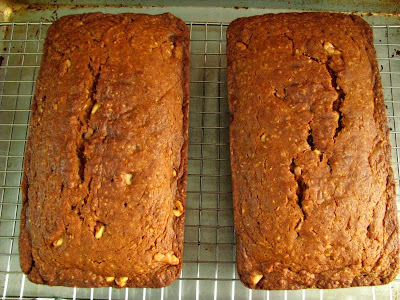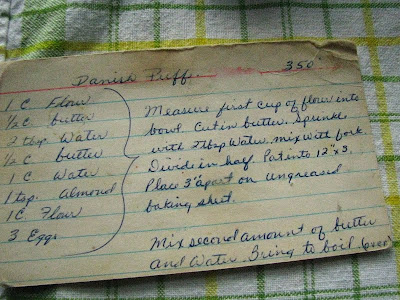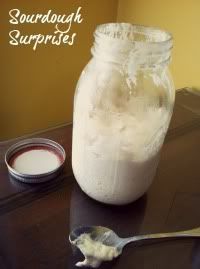
In the chicken yard of baked goods, muffins are probably at the bottom of my baking pecking order. Don't get me wrong, I love them - they just seem to be something more "utilitarian", something to satiate a hunger pang rather than something I'll go out of the way to bake just for the joy of baking. Because they tend to be more virtuous than cupcakes, some muffins beg to be slathered in jam or butter: a hope of becoming more than they are. Some are perfect candidates for the freezer, pucks of frozen nutrition, waiting for me to remember that I stashed them in there. They do come in handy when I remember I'm hungry as I'm running out the door, but I don't often crave them, pushing them aside for other sweet, compact grab-ables such as cookies.
Every once in a while, I make a muffin that I want to eat all 12 of, and then set out to make a second batch. When that happens, I make a note and then change my tune. "What was I thinking", I ask myself, "I love muffins"! I would all of a sudden travel the world over to be able to crawl humbly back to my kitchen and mix up a batch of hand-sized quick breads, and I wouldn't even wait for them to cool before popping them into my mouth.

I have two confessions, and one of them involves Martha Stewart. The first confession is that I'm cheap. I like to think I'm cheap with class, but not always is that the case. When standing overwhelmed at the baking aisle at the non-food-co-op-grocery prior to Thanksgiving, I evil-eyed the cans of pumpkin. I don't know why, but I could not bring myself to buy the 15 oz. cans, when the 29 oz. cans were cheaper per ounce. I solemnly cursed the manufacturers that they are always putting one ounce less in something just so that a purist baker somewhere will succumb to buying the 15 oz. cans instead of a 29 oz. can so that she won't be short. Seeing as I don't buy all that much canned food, my steaming was brief, but still. Do they think I don't notice? I do. I still buy the large cans to spite them, then store the leftovers in the fridge for a few days until I can figure out what to do with them... in the case of this post, making pumpkin muffins.
My second (and unrelated) confession is that I have no real opinion about Martha Stewart. She's smart, obviously driven, and has more well appointed houses than I'll ever have. She cooks, bakes, decorates, and reads and still has time to gild a lily. I like her books, love their layouts and photography, but often find fault in her recipes. I take her recommends with a grain of salt, and don't buy into every new adventure she concocts. When I grabbed SoNo Baking Company Cookbook from the new shelf at the library, admittedly it was for the gorgeous cover. When I opened it up and read the preface by Martha herself, I discovered that it's writer was at one time one of the minions of Martha's staff. I had the book sitting on the counter for 2 weeks before reading any further.
Just a few days ago, I finally cracked it back open and was rewarded handsomely with this recipe. Besides a tome of hugely interesting baked goods, I also found in it that I shouldn't judge Martha. She is what she is, and she does recognize great talent. John Barricelli writes this book well, and also clearly has amazing ideas about baking. When I couldn't actually decide what muffin to try first, I knew he had me. And after the first bite of soft, almost-as-good-as-a-cupcake pumpkin muffin, I knew that this indeed is a great book.

I hardly alterered John's recipe. I did reduce the sugar slightly (and I used raw instead) and omitted the raisins on request of the Boy-O. He eats them fine on their own, but doesn't like them "in things" all of a sudden. I added walnuts instead, and sprinkled some on the tops prior to baking. Because the muffin is so moist and cake-like, they stuck out like ants on a rock. No matter, they tasted great all toasted up. Next time, I'll probably leave them off though.
Pumpkin Muffins (adapted from John Barricelli, The SoNo Baking Company Cookbook)
In a medium bowl, whisk flour, baking soda, salt and spices together.
In a large bowl, whisk sugar, oil, eggs, pumpkin and applesauce together. Add the dry ingredients and fold until the mixture is well combined. Fold in raisins and chia seeds if using, and any other mix-ins.
Portion into muffin tin, about 1/4 c. per muffin (I use a disher). Bake for 20-25 minutes, until tester comes out clean.
Transfer pan to a rack to cool for 10 minutes. Then, using a knife as an aid, gently upturn the muffins onto their sides to cool completely in the pans.
- 1 1/2 c. ap flour
- 1 t. baking soda
- 1 t. kosher salt
- 1/2 t. cinnamon
- 1/2 t. ground ginger (or 1/2 T. grated fresh ginger)
- 1/4 t. ground nutmeg
- 1/2 t. ground cloves
- 1 c. sugar (1/2 cup is plenty!)
- 1/2 c. coconut oil (or part coconut part olive oil)
- 2 eggs, room temperature
- 15 oz. pumpkin puree (I just now noticed that the recipe called for half a can of pumpkin... I used a whole can equivalent, and I was more than happy with the results!)
- 1/4 c. unsweetened applesauce
- 1/2 c. raisins, optional (John suggests adding 1/2 c. nuts and/or chocolate chips as well)
- 2 T. chia seeds, optional
In a medium bowl, whisk flour, baking soda, salt and spices together.
In a large bowl, whisk sugar, oil, eggs, pumpkin and applesauce together. Add the dry ingredients and fold until the mixture is well combined. Fold in raisins and chia seeds if using, and any other mix-ins.
Portion into muffin tin, about 1/4 c. per muffin (I use a disher). Bake for 20-25 minutes, until tester comes out clean.
Transfer pan to a rack to cool for 10 minutes. Then, using a knife as an aid, gently upturn the muffins onto their sides to cool completely in the pans.

Well, I guess the extra pumpkin I unknowingly added explains the incredibly soft and custard-like interiors... and why I got more than a dozen. I baked the remaining batter into bite-sized mini muffins, and Boy-O ate all 6 of them straight away, I ate the remaining 2. He was impatient for the bigger ones to cool, and couldn't wait to gobble up even more of them, so we know this is a good recipe.
Just as I was thinking I was "pumpkin-ed out", these beauties prove me wrong. I almost think that I could never be tired of pumpkin. Or muffins. Now that we're best friends again, the muffin and I have to have some more serious talks. If you have any varietals that I need to meet, please be sure to let me know. Meanwhile, it's almost cookieposter time... unless I decide to give Christmas Muffins this year. I doubt I'd hear any complaints if I use more of John Barricelli's recipes.


























































